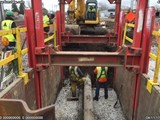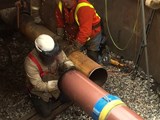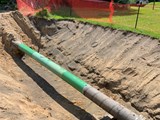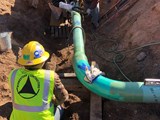Trench Safety
The following press release from OSHA describes how dangerous trenches can be. A cubic yard of soil can weigh up to 3,000 lbs. Workers can be crushed and buried alive in an instant if an unsupported trench wall gives away. Trenches, shallow or deep, can also become filled with toxic, heavier than air gas that can cause asphyxiation. Midwestern Contractors trains and reinforces the principles of trench safety on a regular basis. One mistake with trench safety can cause great harm. Trenches must have:
- Wall stability either by sloping or trench boxes
- Safe means of entry and exit
- Safe atmosphere, free of explosive or asphyxiating gases, and standing water
See OSHA press release https://www.osha.gov/news/newsreleases Trench Safety
OSHA National News Release
U.S. Department of Labor
July 14, 2022
Alarming rise in trench-related fatalities spurs US Department of Labor to announce enhanced nationwide enforcement, additional oversight
22 workers have perished in first half of 2022
WASHINGTON – In 2022's first six months, 22 workers have fallen victim to the deadly hazards present in trenching and excavation work – surpassing 15 in all of 2021 – and prompting the U.S. Department of Labor's Occupational Safety and Health Administration to launch enhanced enforcement initiatives to protect workers from known industry hazards.
To stress the dangers of disregarding federal workplace safety requirements for trenching and excavation work, OSHA enforcement staff will consider every available tool at the agency's disposal. These actions will place additional emphasis on how agency officials evaluate penalties for trenching and excavation related incidents, including criminal referrals for federal or state prosecution to hold employers and others accountable when their actions or inactions kill workers or put their lives at risk.
In keeping with its National Emphasis Program for excavations, OSHA compliance officers will perform more than 1,000 trench inspections nationwide where they may stop by, and inspect, any excavation site during their daily duties.
"The Occupational Safety and Health Administration is calling on all employers engaged in trenching and excavation activities to act immediately to ensure that required protections are fully in place every single time their employees step down into or work near a trench," said Assistant Secretary for Occupational Safety and Health Doug Parker. "In a matter of seconds, workers can be crushed and buried under thousands of pounds of soil and rocks in an unsafe trench. The alarming increase in the number of workers needlessly dying and suffering serious injuries in trenching incidents must be stopped."
"Every one of these tragedies could have been prevented had employers complied with OSHA standards," Parker continued. "There simply is no excuse for ignoring safety requirements to prevent trench collapses and cave-ins, and leaving families, friends and co-workers to grieve when the solutions are so well-understood."
A recent incident in central Texas highlights the dangers of trenching and an impetus for OSHA's action. On June 28, 2022, two workers, aged 20 and 39, suffered fatal injuries in Jarrell, Texas, when the unprotected trench more than 20 feet deep collapsed upon them as they worked. Trench shields, which could have saved their lives, sat unused beside the excavation.
Trenching and excavation operations require protective systems and inspections before workers can enter. When employers fail to install trench protection systems or properly inspect the trench, workers are exposed to serious hazards, including risk of being buried under thousands of pounds of soil. By some estimates, a cubic yard of soil can weigh as much as 3,000 pounds, equal to that of a compact car.
States that operate their own Occupational Safety and Health plan have similar emphasis programs in place, and OSHA also encourages those states to consider additional measures, including criminal referrals for federal or state prosecution for trenching-related incidents.
Trenching standards require protective systems on trenches deeper than 5 feet and soil and other materials kept at least 2 feet from the edge of a trench. Additionally, trenches must be inspected by a knowledgeable person, be free of standing water and atmospheric hazards and have a safe means of entering and exiting prior to allowing a worker to enter.
"OSHA stands ready to assist any employer who needs help to comply with our trenching and excavation requirements," Parker added. "We will conduct outreach programs, including safety summits, in all of our 10 regions to help ensure any employer who wants assistance gets it. The stakes are too important."
OSHA's On-Site Consultation Program, a free and confidential health and safety consulting program for small- and medium-sized businesses, will assist employers in developing strategic approaches for addressing trench-related illnesses and injuries in workplaces.
The agency also urges workers to contact their local OSHA or state plan office, or call 800-321-OSHA, if their employer requires working in or beside trenches that are not sloped, shored, or shielded and are five or more feet in depth.
OSHA's trenching and excavation webpage provides additional information on trenching hazards and solutions, including a safety video.
# # #
Media Contacts:
Mandy McClure, 202-693-4675, mcclure.amanda.c@dol.gov
Denisha Braxton, 202-693-5061, braxton.denisha.l@dol.gov
Release Number: 22-1491-NAT




